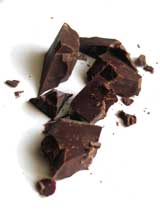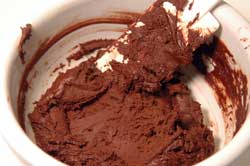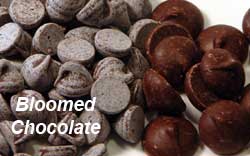Know chocolate’s key temperature. The principal secret in working with chocolate is remembering that its melting point is about 95 degrees F. Different cacao percentages and various brands may vary slightly, but generally fall into the mid-90’s. To manipulate chocolate, one rarely needs to heat chocolate more than body temperature.
 Know your chocolate brands. There are two types of chocolate makers: (1) those that control the process from harvest to bar, and (2) those that buy partially processed cacao, (a ground slurry known as chocolate liquor), and complete the chocolate making process. Chocolate makers tout the quality of their cacao, blends of cacao beans, and their product’s consistency. Experiment with different quality chocolates. A smooth, glossy appearance, a healthy snap when broken, and a wonderful melt-in-your mouth feel are characteristic of a good chocolate. Know your chocolate brands. There are two types of chocolate makers: (1) those that control the process from harvest to bar, and (2) those that buy partially processed cacao, (a ground slurry known as chocolate liquor), and complete the chocolate making process. Chocolate makers tout the quality of their cacao, blends of cacao beans, and their product’s consistency. Experiment with different quality chocolates. A smooth, glossy appearance, a healthy snap when broken, and a wonderful melt-in-your mouth feel are characteristic of a good chocolate.
Know how to temper your chocolate. Tempering chocolate is a specific process of heating and cooling the chocolate that produces the best texture and taste. Chocolate has a crystalline structure that may shift when stored at different temperatures and humidity levels. The cocoa butter component of chocolate solidifies into six different types of crystals, I - VI. Each crystal type affects the chocolate’s melting point, texture, and appearance. Crystal type V produces the most desirable chocolate characteristics, glossy, firm, and a melting point of 94 degrees F. Tempering chocolate allows for the greatest number of Type V crystals to be formed upon hardening. To temper chocolate, melt the chocolate in a double boiler or bowl over barely simmering water until all pieces are nearly melted and the chocolate’s temperature is 95-96 degrees. Remove from heat and continue stirring until the melting is complete. Allow to cool. Alternatively, set aside one-quarter of the chocolate to be melted, melt the remainder of the chocolate over barely simmering water until all melted. Remove from heat, add the reserved chocolate as “seed” crystals for the cooling chocolate. Tempering chocolate produces a product that is glossy, structurally strong, and smooth in the mouth.
 Know how to avoid seizing of the chocolate. It’s happens at least once to every cook – a lovely bowl of melted chocolate suddenly becomes stiff, lumpy and grainy. What happened? Chocolate is a suspension of solid particles in cocoa butter. If even a drop of water, or condensed steam from the water bath lands in the melted chocolate, the solid particles absorb the liquid and become inspired to glom onto each other. The result is a stiff, grainy texture. There is no recovery from this situation other than to start over with fresh chocolate. Know how to avoid seizing of the chocolate. It’s happens at least once to every cook – a lovely bowl of melted chocolate suddenly becomes stiff, lumpy and grainy. What happened? Chocolate is a suspension of solid particles in cocoa butter. If even a drop of water, or condensed steam from the water bath lands in the melted chocolate, the solid particles absorb the liquid and become inspired to glom onto each other. The result is a stiff, grainy texture. There is no recovery from this situation other than to start over with fresh chocolate.
 Know how to repair chocolate bloom. Chocolate bloom appears as a grayish-white discoloration on the chocolate’s surface. The discoloration can be either fat bloom, or sugar bloom. Fat bloom occurs as a result of slight melting and separation of chocolate components on the surface. The white is recrystallized cocoa butter. Sugar bloom may occur when the chocolate has come in contact with heavy moisture resulting in some of the sugar crystals dissolving, and then recrystallizing as the moisture dries away. Bloom results when the chocolate has been improperly stored. While undesirable in appearance, blooming chocolate has little effect on the chocolate’s taste and may be repaired through a tempering process. Know how to repair chocolate bloom. Chocolate bloom appears as a grayish-white discoloration on the chocolate’s surface. The discoloration can be either fat bloom, or sugar bloom. Fat bloom occurs as a result of slight melting and separation of chocolate components on the surface. The white is recrystallized cocoa butter. Sugar bloom may occur when the chocolate has come in contact with heavy moisture resulting in some of the sugar crystals dissolving, and then recrystallizing as the moisture dries away. Bloom results when the chocolate has been improperly stored. While undesirable in appearance, blooming chocolate has little effect on the chocolate’s taste and may be repaired through a tempering process.
|

